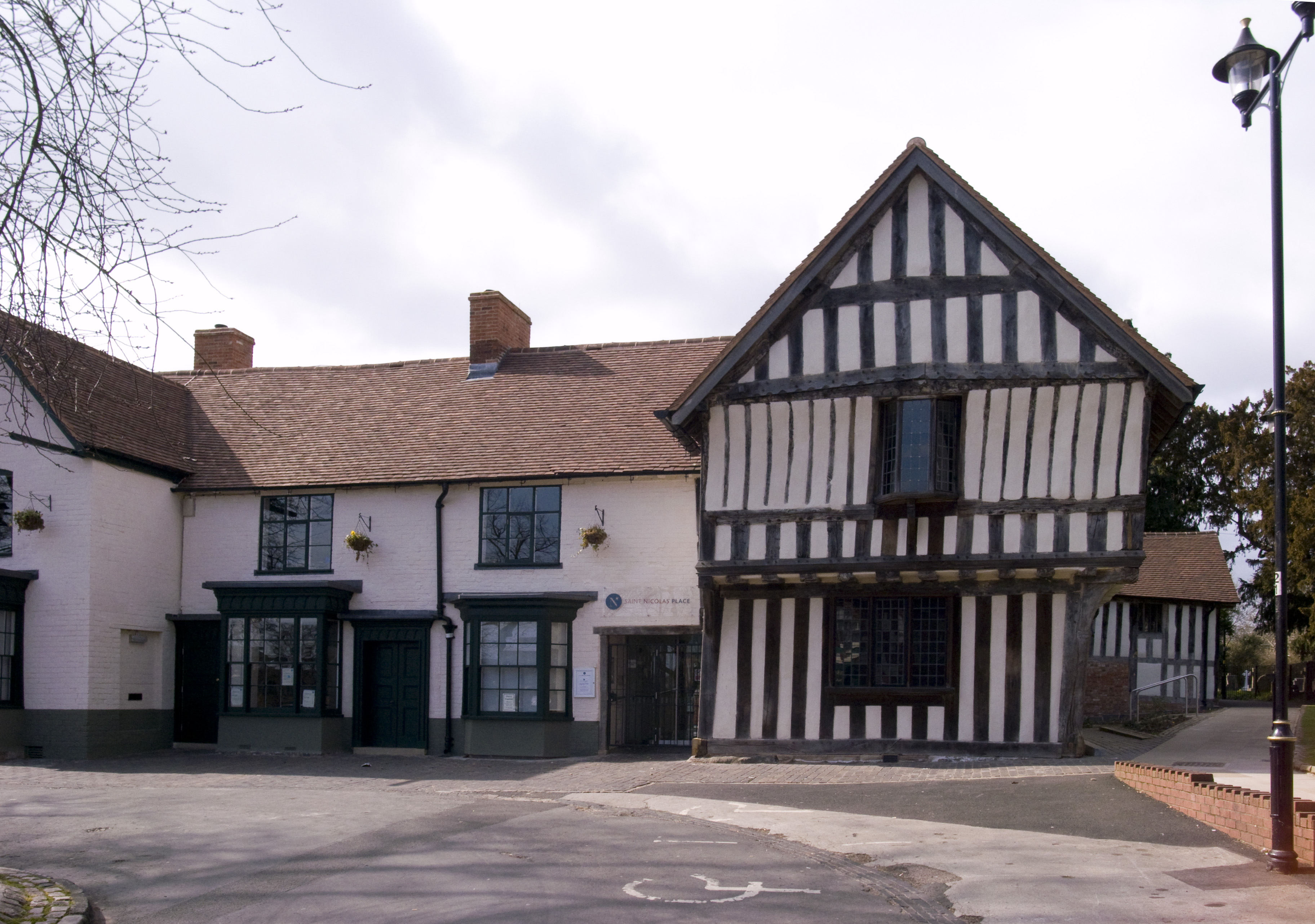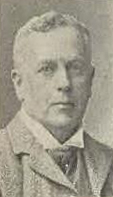|
St. Nicolas' Church, Kings Norton
St Nicolas' Church, Kings Norton, is the Anglican parish church of Kings Norton, in the Diocese of Birmingham, West Midlands, England. History A church has been located on this site as early as the 11th century when the Normans built a small, rectangular chapel. It is not known if this was the result of a rebuild of a previous church. A church on this site has been recorded in documents since 1213. The current St Nicolas's Church dates from the early 13th century, and the spire was constructed between 1446 and 1475. The Norman building was demolished in the 14th century when a new nave, both aisles and the chancel arch were constructed. In the 17th century, almost the whole of the south aisle was re-built, the chancel was re-roofed and the low pitched roof that covered the nave from the 15th century was replaced by a much steeper version. Both north aisle and south aisle were given four separate, high pitched roofs set side by side. A parish was assigned to the church in 1846. T ... [...More Info...] [...Related Items...] OR: [Wikipedia] [Google] [Baidu] |
St Nicholas
Saint Nicholas of Myra (traditionally 15 March 270 – 6 December 343), also known as Nicholas of Bari, was an early Christian bishop of Greeks, Greek descent from the maritime city of Patara (Lycia), Patara in Anatolia (in modern-day Antalya Province, Turkey) during the time of the Roman Empire. Because of the many miracles attributed to his intercession, he is also known as Nicholas the Wonderworker. Saint Nicholas is the patron saint of sailors, merchants, archers, repentant thieves, children, brewers, pawnbrokers, toymakers, unmarried people, and students in various cities and countries around Europe. His reputation evolved among the pious, as was common for early Christian saints, and his legendary habit of secret gift-giving gave rise to the folklore of Santa Claus ("Saint Nick") through Sinterklaas. Little is known about the historical Saint Nicholas. The earliest accounts of his life were written centuries after his death and probably contain legendary elaborations. H ... [...More Info...] [...Related Items...] OR: [Wikipedia] [Google] [Baidu] |
Saracen's Head
The Saracen's Head is the name formerly given to one of a group of late medieval buildings in Kings Norton, Birmingham. The buildings, together with the nearby Old Grammar School, won the BBC '' Restoration'' series in 2004. Following the restoration project, the Old Grammar School, Saint Nicolas Church and the Tudor Merchant's House (formerly the Saracen's Head) were given the collective name of Saint Nicolas Place. Location The Old Grammar School and a 15th-century timber-framed house stand around the 12th century church of St Nicolas at The Green in Kings Norton. They lie adjacent to the churchyard of St Nicolas church, at the north west of the village green. Winners of BBC Restoration 2004, the Old Grammar School along with the medieval house are buildings of considerable historical and architectural importance. The Old Grammar School and the Tudor Merchant's House, both Grade II* listed, are owned by King's Norton Parish Church, which was unable to restore adequately th ... [...More Info...] [...Related Items...] OR: [Wikipedia] [Google] [Baidu] |
St Laurence's Church, Northfield
St. Laurence's Church, Northfield is a parish church in the Church of England in Northfield, Birmingham. The church is in a conservation area near nail maker's cottages, the Great Stone Inn, the old school and the Village Pound. History The Grade I listed church dates from the 12th century and contains some of the finest Early English work in the county. It also has a rare 14th-century timber porch outside the south door. The church and parish were originally controlled from the Priory of St. James, in Dudley. The north aisle was added in 1900 by George Frederick Bodley. The gridiron associated with the martyrdom of St. Laurence can be seen in the stonework of the church tower. Patronage Keble College, Oxford own the Advowson to the Rectory. A list of the Patrons and Rectors from the Domesday Book to the present day can be found in the history section of the Churcweb site Bells The ring of eight bells was increased to ten on 20 November 1999. At the same time a new ... [...More Info...] [...Related Items...] OR: [Wikipedia] [Google] [Baidu] |
Listed Buildings In Birmingham
There are 1,946 listed buildings in Birmingham, England. This list by district includes those of Grade I and Grade II* importance, plus a selection of those of Grade II importance that are otherwise noteworthy. It also includes the scheduled monuments in the city (indicated by the letters AM). As of April 2006 there are 23 Grade I, 95 Grade II*, 1,828 Grade II, and 13 scheduled monuments. __NOTOC__ See also * Grade I listed buildings in the West Midlands#Birmingham * Grade II* listed buildings in the West Midlands#Birmingham * Listed pubs in Birmingham References *Foster, Andy. ''Pevsner Architectural Guides: Birmingham''. Yale University Press: New Haven & London, 2005 Consolidated List of Statutorily Listed Buildings - Birmingham (full list in PDF format)- Birmingham City CouncilThe Victorian Society - Birmingham & West Midlands Group {{DEFAULTSORT:Listed Buildings In Birmingham * Birmingham Birmingham Birmingham ( ) is a City status in the United Kingdom, ci ... [...More Info...] [...Related Items...] OR: [Wikipedia] [Google] [Baidu] |
Christchurch Priory
Christchurch Priory is an ecclesiastical parish and former priory church in Christchurch in the English county of Dorset (formerly in Hampshire). It is one of the longest parish churches in the country and is as large as many of the Church of England Cathedrals. Early history The story of Christchurch Priory goes back to at least the middle of the 11th century, as the Domesday Book of 1086 says there was a priory of 24 secular canons here in the reign of Edward the Confessor. The Priory is on the site of an earlier church dating from 800AD. In 1094 a chief minister of William II, Ranulf Flambard, then Dean of Twynham, began the building of a church. Local legend has it that Flambard originally intended the church to be built on top of nearby St. Catherine's Hill but during the night all the building materials were mysteriously transported to the site of the present priory. Although in 1099 Flambard was appointed Bishop of Durham, work continued under his successors. A mi ... [...More Info...] [...Related Items...] OR: [Wikipedia] [Google] [Baidu] |
Bristol Cathedral
Bristol Cathedral, formally the Cathedral Church of the Holy and Undivided Trinity, is a Church of England cathedral in the city of Bristol, England. It is the seat of the Bishop of Bristol. The cathedral was originally an abbey dedicated to St Augustine, founded in 1140 and consecrated in 1148. It became the cathedral of the new diocese of Bristol in 1542, after the dissolution of the monasteries. It is a Grade I listed building. The earliest surviving fabric is the late 12th century chapter house, which contains some of the first uses of pointed arches in England. The eastern end of the church is medieval, the oldest part being the early 13th century Elder Lady Chapel. The remainder of the east end was rebuilt in the English Decorated Gothic style during the 14th century as a hall church, with aisles the same height as the central choir. In the 15th century the transepts were rebuilt and the central tower added. The nave was incomplete when the abbey was dissolved in 1539 ... [...More Info...] [...Related Items...] OR: [Wikipedia] [Google] [Baidu] |
Brecon Cathedral
Brecon Cathedral (), in the town of Brecon, Powys, is the cathedral of the Diocese of Swansea and Brecon in the Church in Wales and seat of the Bishop of Swansea and Brecon. Previously the church of Brecon Priory and then the Parish Church of St John the Evangelist, it became Brecon Cathedral following the disestablishment of the Church in Wales in 1920 and the creation of the diocese in 1923. History Because of the characteristic round shape of its churchyard, the cathedral is thought to be on the site of an earlier Celtic church, of which no trace remains. A new church, dedicated to St. John, was built on the orders of Bernard de Neufmarché, the Norman knight who conquered the kingdom of Brycheiniog in 1093. He gave the church to one of his followers, Roger, a monk from Battle Abbey, who founded a priory on the site as a daughter house of Battle. The first prior at Brecon was Walter, another monk from Battle. Bernard de Neufmarché also endowed the priory with lands, right ... [...More Info...] [...Related Items...] OR: [Wikipedia] [Google] [Baidu] |
David Gwerfyl Davies
David Gwerfyl Davies (1 February 1913 – 1977) was a Welsh organist and composer. Background He was born on 1 February 1913. He was a pupil at Merthyr Tydfil County Grammar School and then University College, Cardiff. He was awarded his BA in music in 1937. After the Second World War he took the degree of Mus.B. at Trinity College, Cambridge and graduated in 1954. Appointments *Organist at St Nicolas' Church, Kings Norton 1950 - 1953 *Organist at Brecon Cathedral Brecon Cathedral (), in the town of Brecon, Powys, is the cathedral of the Diocese of Swansea and Brecon in the Church in Wales and seat of the Bishop of Swansea and Brecon. Previously the church of Brecon Priory and then the Parish Church of S ... 1956 – 1963''The organists and organs of the Welsh cathedrals in the 20th century''. Enid Bird. 1992 Compositions He composed church and organ music. References {{DEFAULTSORT:Davies, David Gwerfyl 1913 births 1977 deaths Welsh classical organists Welsh ... [...More Info...] [...Related Items...] OR: [Wikipedia] [Google] [Baidu] |
Herbert Walter Wareing
Herbert Walter Wareing (5 April 1857 – 29 March 1918) was an organist and composer based in England.Who's who in music, Henry Saxe Wyndham, 1915 Life Wareing was the son of John Wareing and Martha Jane. He studied under Dr. Charles Swinnerton Heap, and at the Leipzig Conservatoire under Karl Reinecke, Salomon Jadassohn and Ernst Richter. He graduated Mus. Bac from the University of Cambridge in 1882 and Mus. Doc in 1886. Wareing was professor of pianoforte at Malvern College, and directory of the Worcester Cathedral Choir School. He married Louisa Susanna Millward in 1892. Appointments *Organist of St John's Church, Wolverhampton 1876–79 *Organist of St Bartholomew's Church, Edgbaston, Birmingham 1881–88 *Organist of St. Nicolas' Church, Kings Norton 1891–1906 *Organist of Christ Church, Malvern 1911–18 Compositions His compositions include: *Cantatas, Prayer and Praise; New Year's Eve; The Wreck of the Hesperus, for tenor and bass soli, chorus ... [...More Info...] [...Related Items...] OR: [Wikipedia] [Google] [Baidu] |





